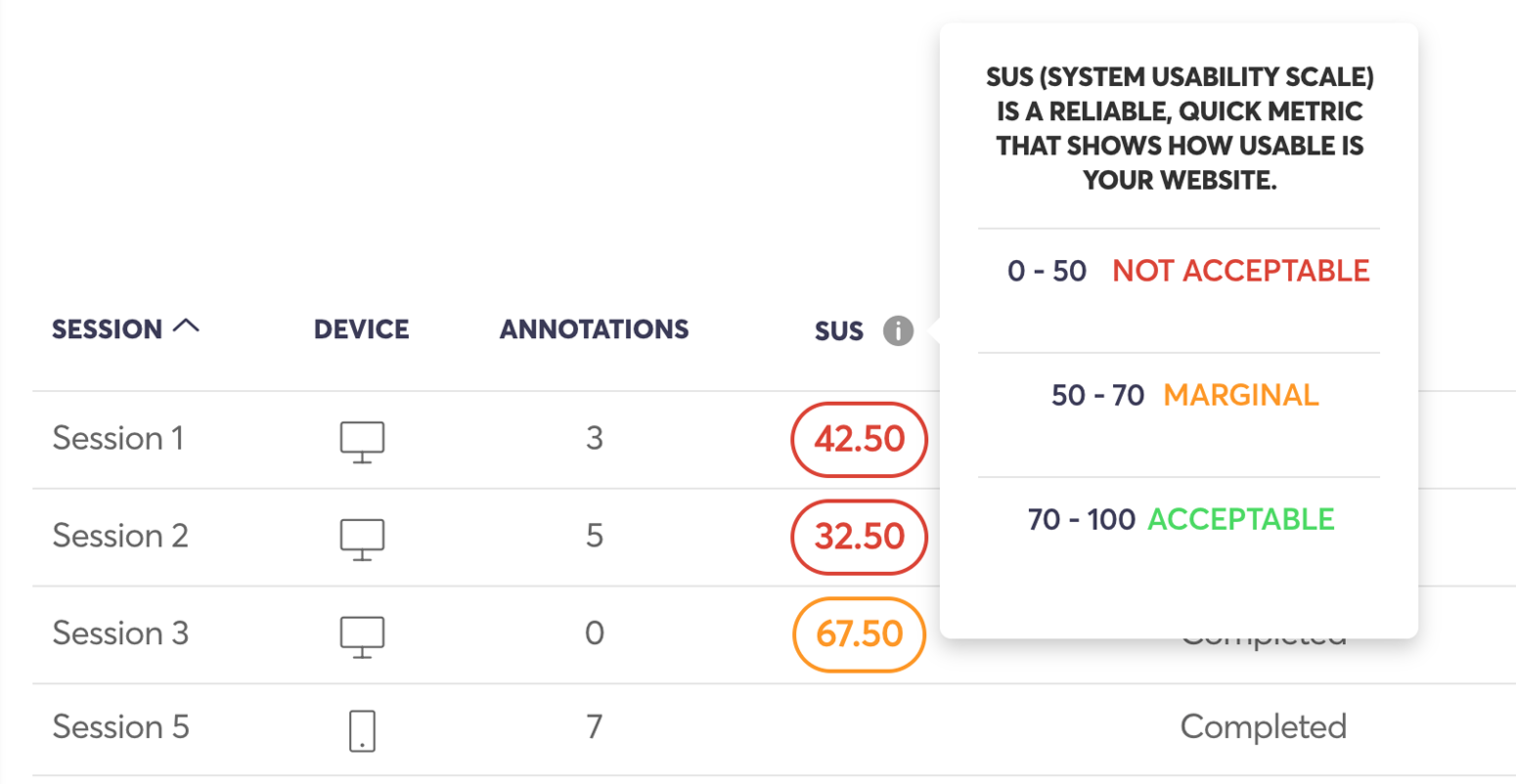
Now in each usability test you run through Userfeel.com, you site's SUS (System Usability Scale) is automatically measured!
What is SUS?
The System Usability Scale (SUS) was invented by John Brooke in 1986 and is a quick and dirty but trusted way to measure the perceived usability of your website or app. It can be used to rate the usability of any system: websites, online stores, and online applications, but also mobile phones, computing systems, software, call centers, and even phone directories.
The SUS rating is a number from 0 to 100. The higher the SUS of your site, the easier it is to use. The SUS is derived from a 10-item questionnaire that users answer after completing a test. The answers are on a scale of 1 to 5, where one means that they disagree completely and five that they fully agree.
The ten SUS questions are the following:
- I think that I would like to use this system frequently.
- I found the system unnecessarily complex.
- I thought the system was easy to use.
- I think that I would need the support of a technical person to be able to use this system.
- I found the various functions in this system were well integrated.
- I thought there was too much inconsistency in this system.
- I would imagine that most people would learn to use this system very quickly.
- I found the system very cumbersome to use.
- I felt very confident using the system.
- I needed to learn a lot of things before I could get going with this system.
The reliability of the SUS score has been evaluated over the years by many researchers and has been found to be on par with much more complex and costly methods. A further advantage is that a relatively small sample of users is enough to give a pretty good estimation.
Among the thousands of websites that have been rated by SUS, there has been an average score of 68. So if your site scores below 68, it means it is worse than average; if it scores over 68, it is better than average.
SUS and customer loyalty
The SUS rating has been found to have a high correlation with customer loyalty, as well as with the likelihood of a user to recommend the website or app to friends (LTR — likelihood to recommend).
In particular, it has been measured that when the SUS score is divided by 10, it roughly matches the Net PromoterSscore, which is an 11-point scale (0-10) that shows the LTR, i.e., how likely it is for the user to recommend the website or app to others. So if your website has a SUS score over 80, there is a good chance that the site will be recommended, while if it has a SUS score under 70, it may get negative reviews or comments.
Keep track of the evolution of SUS over time
One advantage of measuring SUS is that we can monitor how it evolves over time. In this way, we can see if our actions (redesign, changes, new features) or even our non-actions (age, competition) affect the perceived usability of our site.
SUS shows problematic test sessions at a glance
The SUS score is measured by default on every usability test you run through Userfeel and you see it on both the results page and on your dashboard next to each test session. In addition, the average SUS score for all test sessions of the given usability study per device type (desktop, mobile, or tablet) is displayed.
A low SUS score for a test session indicates that that particular user had difficulty completing a task, so it is a test session that you should watch as it will probably provide essential findings.
This is very useful, especially for large-scale usability studies, when some team members may only want to find and watch the most "juicy" videos.
Interpretation of the SUS rating
Although the SUS score is a number from 1 to 100, the scale is not a percentage. So if your site has a SUS score of 80, it does not mean it is better than 80% of the websites. The reason is that the average of the SUS scale is not 50, but 68. Tables converting SUS scores to a percentage scale and other scales such as A to F can be found online.
SUS
At Userfeel we chose to show a straightforward, 3-level interpretation next to each SUS Rating: Acceptable, Marginal, Not Acceptable.
SUS and SEO
Although there is no published scientific research on the correlation of SUS and SEO rankings (site rankings on Google's organic results), Google does take usability into account when ranking websites.
So, since the SUS score measures usability, it makes sense to try to increase the SUS of your website in order to get the best rankings on Google.
Find the SUS of your own site
The Userfeel team is ready to help you run a usability test for your own website or app so you can find out not just what its SUS score is and how it is ranked in terms of the competition, but also to discover what issues make it difficult for its users.
Usability testing is one of the most cost-effective investments you can make. According to a Norman Nielsen Group study, investing 10% of your website's development budget in usability testing yields an 83% increase in conversion rates!
Contact us to help set up your usability testing plan.

By Yannis
CEO & Founder
Published on 07 Apr 2017

